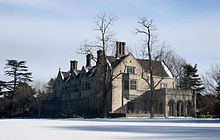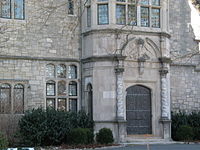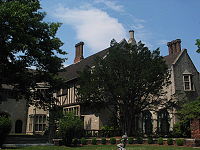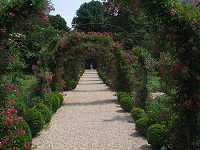- Planting Fields Arboretum State Historic Park
-
Planting Fields Arboretum
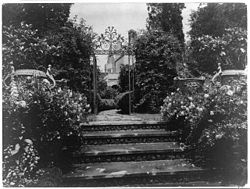 "Planting Fields", estate of William R. Coe, Oyster Bay, New York photo from U.S. Library of Congress collection
"Planting Fields", estate of William R. Coe, Oyster Bay, New York photo from U.S. Library of Congress collectionNearest city: Oyster Bay, New York Built: 1915 Architect: Guy Lowell; Walker & Gillette Architectural style: Tudor Revival, Other Governing body: State NRHP Reference#: 79001598[1] Added to NRHP: January 25, 1979 Planting Fields Arboretum State Historic Park, which includes the Coe Hall Historic House Museum, is an arboretum and state park covering over 400 acres (160 ha) located in the Village of Upper Brookville in the town of Oyster Bay, New York.
Near the end of America's Gilded Age, the estate named Planting Fields was the home of William Robertson Coe, an insurance and railroad executive, and his wife Mary "Mai" Huttleston (née Rogers) Coe, the youngest daughter of millionaire industrialist Henry H. Rogers, who had been a principal of Standard Oil. It includes the 67-room Coe Hall, greenhouses, gardens, woodland paths, and outstanding plant collections. Its grounds were designed by Guy Lowell, A. R. Sargent, the Olmsted Brothers, and others. Planting Fields also features an herbarium of over 10,000 pressed specimens.
The name "Planting Fields" comes from the Matinecock Indians who cultivated the rich soil in the clearings high above Long Island Sound.
Contents
History
The history of the present-day property on the famous "Gold Coast" of Long Island began between 1904 and 1912, when Helen MacGregor Byrne – wife of New York City lawyer James Byrne – purchased six farming properties which she collectively referred to as "Upper Planting Fields Farm". The Byrnes hired landscape architect James Greenleaf between 1904 and 1910 to create hedges, perennial borders, and espaliered fruit trees. Though notable features from this period are the Rose Arbor, the Circular Pool and the Green Garden Court, Coe recalled in later life, "Mrs Byrne had done very little in the shape of landscaping. She had a small lawn around the ridge of the residence" and next to it a cornfield. Most of the property, Coe recalled, was "just a jungle of scrub, locusts, and other trees".[2]
In 1913, William Robertson Coe purchased the house and 353-acre (143 ha) estate, and began today's plantings and landscaping under the guidance of the Boston landscaping firm of Guy Lowell and A. Robeson Sargent, son of Charles Sargent, founder of the Arnold Arboretum. In 1915, Lowell and Sargent oversaw transport of two gigantic beeches from Fairhaven, Massachusetts, the childhood home of Mary "Mai" Huttleston (née Rogers) Coe (who was the daughter of Henry H. Rogers of Standard Oil). The trees, with root balls 30 feet (9.1 m) in diameter, were ferried across Long Island Sound in mid-winter. Roads were widened and utility wires temporarily removed to make way. Only one of the two trees survived the journey. Unfortunately, the second beech tree has recently died, and was taken down in February 2006. However, the “Fairhaven Beech” will live on: seedlings were collected from the tree from 2000-2005.
Massive purchases of rhododendrons were made in England, Japanese crabapples and cherries, and forest and specimen trees, lindens, Scotch and red pines, oaks. Through the English nurseryman Glomar Waterer, who had sold Mr Coe the rhododendrons, came an offer in 1916 of an unusually fine collection of camellias located in Guernsey, for which the Camellia House was constructed by "Bobo" Sargent in autumn 1917, and filled with the plants grown in tubs that were shipped the following spring. Most of them were selected varieties of Camellia japonica but there were six Camellia reticulata, never before grown in the United States.
The property's first mansion burned to the ground on March 19, 1918; its replacement, the present Coe Hall, was constructed between 1918 and 1921 in the Tudor Revival style and faced in Indiana limestone. It was designed by the firm of Walker & Gillette and was completed in 1921. Images from a book of English country houses inspired its architecture, especially those of Moyns Park, Athelhampton, and St. Catherine's Court.
William and Mai Coe's interest in rare species of trees and plant collections made the estate a botanical marvel. Mai, who was chronically ill for the last decade of her life, died on December 28, 1924 at the age of forty-nine and is buried nearby. The 353-acre (1.43 km2) estate was deeded to the State of New York in 1949 (during Mr. Coe's lifetime) to become a state park.
The main gardens
Sargent created The Italian Blue Pool Garden between 1914 and 1918, with the Tea House built in 1915 to designs by Guy Lowell. Historically this garden was planted with spring-blooming perennials such as delphiniums, irises, peonies, and poppies. It is currently being restored to this original form.
After the unexpected death of A.R. Sargent in 1918, the Coes appointed the Olmsted Brothers of Brookline, Massachusetts, with James Frederick Dawson as chief landscape architect, who brought their signature "naturalistic" look to the north side of the property. They completed additions to the Main Greenhouse and Camellia Greenhouse, as well as the Beech Copse, Main Lawn, West Lawn and Heather Garden.
The Green Garden features a circular pool. Nearby Azalea Walks and Vista Path show hundreds of varieties of Azalea and Rhododendron. The Rose Arbor and Rose Garden contain over 680 Tea, shrub, and miniature roses.
The Synoptic Garden displays over 500 types of tree and shrub, arranged in alphabetical order by botanical name.
The Magnolia Collection contains over 80 types of deciduous and evergreen Magnolia.
The Rhododendron Collection shows over 1,000 types of azalea and rhododendron.
The Camellia Greenhouse (Lowell & Sargent, 1917; revised and extended by Olmsted Brothers, 1917–1922)[3] was built specifically to house the Camellia collection, originally of 114 full-grown plants; currently the collection consists of over 300 plants. It was James F. Dawson's idea to sink the tubs directly in the ground, rather than trundle them out seasonally, the usual procedure for camellias grown in greenhouses.
The Main Greenhouse (Lowell & Sargent/Olmsted Brothers) was constructed between 1914 and 1929, with a Hibiscus House added in 1929 for the Coes' Hibiscus collection. Today, the Main Greenhouse offers large collections of orchids, cacti and succulents, houseplants, ferns and Begonias, as well as seasonal displays of Chrysanthemum, Poinsettia, Hydrangea, Coleus, etc.
The North Border features the Holly collection, Dwarf Conifer Garden, Conifer Trail, Heather Garden, and Species Rhododendron. The Holly collection includes over 100 different types of evergreen hollies such as English, American, Asian and hybrid forms. The Dwarf Conifer Garden features dozens of varieties of spruce, fir, Chamaecyparis, Juniper, Pine, etc. The nearby full-scale conifers can reach over 60 feet (18 m) tall, and include Sequoia, Dawn Redwood, Larch, Fir, Spruce and Pine, with a large assortment of Rhododendron species under the canopy. The Heather Garden features low growing heaths and heathers, as well as Rhododendron, Azalea, and other flowering plants.
The Dahlia Garden offers several hundred varieties of show-quality Dahlias.
Finally, there are over 200 acres (81 ha) of woodland at Planting Fields, with miles of walking trails through the woods. Before some recent losses the Long Island Horticultural Society reported that eighteen of the trees at Planting Fields were the largest of their species on Long Island.[4]
College campus period
During an interim period between 1955 and 1964, in addition to its role as Planting Fields Arboretum, a park, the land was used as a temporary campus for a State University of New York (SUNY) college of science and engineering, which was known as the State University College On Long Island at Oyster Bay (SUCOLI) while donated land in Stony Brook, NY was developed into the new permanent campus. In 1962 Stony Brook University moved to its new home, and transitioned for a two year period between the campuses. At first all activities were located inside Coe Hall, but as the college grew, dormitories were moved to the stables and temporary dome structures were erected on the grounds for classes and laboratories. Subsequent to SUNY Stony Brook moving to its permanent campus in Suffolk County, the site became home to another SUNY endeavor, the Center for International Studies and World Affairs ("ISWA"). When this SUNY undertaking was shut down in 1968, all facilities and grounds became the current day Planting Fields.
Planting Fields today
Today it is operated by a foundation, and Planting Fields, with its world-renowned arboretum and the Coe Hall mansion, is a popular attraction. The wrought-iron gates, built in Sussex, England in 1712 for Carshalton Park, were imported by Coe in 1921 and have been used as a setting for numerous motion pictures. Planting Fields also hosts an annual summer concert series, primarily focused on jazz.
Planting Fields Arboretum was listed on the National Register of Historic Places in 1979.[5][1]
Gallery
See also
References
- ^ a b "National Register Information System". National Register of Historic Places. National Park Service. 2007-01-23. http://nrhp.focus.nps.gov/natreg/docs/All_Data.html.
- ^ Coe is quoted in Oliver E. Allen, "Mr. Coe's camellia house", Horticulture Magazine January 1984:20-25, p.22.
- ^ The camellia collection and the greenhouse, rebuilt in 1982-84 around the camellias, which are planted directly in the ground, was described by Oliver E. Allen, "Mr. Coe's camellia house", Horticulture Magazine January 1984:20-25, p.22.
- ^ Allen 1984:24.
- ^ O'Brien, Austin N. (November 1, 1978). "National Register of Historic Places Inventory/Nomination: Planting Fields Arboretum". http://www.oprhp.state.ny.us/hpimaging/hp_view.asp?GroupView=4598. Retrieved 2008-02-29. and Accompanying seven photos, from 1978
External links
- Planting Fields Foundation official website
- Planting Fields Arboretum State Historic Park at New York State Parks Recreation & Historic Preservation
Coordinates: 40°51′39″N 73°33′26″W / 40.86083°N 73.55722°W
Protected Areas of New York Federal Eleanor Roosevelt • Home of Franklin D. Roosevelt • Kate Mullany House • Martin Van Buren • Saint Paul's Church • Sagamore Hill • Saratoga National Historical Park • Theodore Roosevelt Birthplace • Theodore Roosevelt Inaugural • Thomas Cole House • Vanderbilt Mansion • Women's Rights National Historical Park
African Burial Ground • Castle Clinton • Federal Hall National Memorial • Fort Stanwix • General Grant National Memorial • Governors Island • Hamilton Grange National Memorial • Statue of Liberty
Appalachian Trail • North Country National Scenic Trail
Amagansett • Conscience Point • Elizabeth A. Morton • Iroquois • Montezuma • Oyster Bay • Sayville • Seatuck • Shawangunk Grasslands • Target Rock • Wallkill River • Wertheim
State Allen H. Treman • Allegany • Amherst • Battle Island • Bayard Cutting Arboretum • Bayswater Point • Bear Mountain • Beaver Island • Beechwood • Belmont Lake • Bethpage • Betty & Wilbur Davis • Big Six Mile Creek • Blauvelt • Bonavista • Bowman Lake • Braddock Bay • Brentwood • Bristol Beach • Brookhaven • Buckhorn Island • Buffalo Harbor • Burnham Point • Buttermilk Falls • Caleb Smith • Camp Hero • Canandaigua Lake • Canoe-Picnic Point • Captree • Catharine Valley Trail • Caumsett • Cayuga Lake • Cedar Island • Cedar Point • Chenango Valley • Cherry Plain • Chimney Bluffs • Chittenango Falls • Clarence Fahnestock • Clark Reservation • Clay Pit Ponds • Cold Spring Harbor • Coles Creek • Conesus Lake • Connetquot River • Crab Island • Croil Island • Cumberland Bay • Darien Lakes • De Veaux Woods • Dean's Cove • Delta Lake • Devil's Hole • Dewolf Point • Donald J. Trump • Earl W. Brydges • Eel Weir • Emma Treadwell Thacher • Empire – Fulton Ferry • Evangola • Fahnestock • Fair Haven Beach • Fillmore Glen • Fort Niagara • Four Mile Creek • Franklin D. Roosevelt • Frenchman Island • Galop Island • Gantry Plaza • Gilbert Lake • Gilgo • Glimmerglass • Golden Hill • Goosepond Mountain • Grafton Lakes • Grass Point • Green Lakes • Hamlin Beach • Harriet Hollister Spencer • Harriman • Haverstraw Beach • Heckscher • Hempstead Lake • High Tor • Highland Lakes • Higley Flow • Hither Hills • Honeoye • Hook Mountain • Hudson Highlands • Hudson River Islands • Hudson River • Hunt's Pond • Iona Island • Irondequoit Bay • Jacques Cartier • James Baird • Jamesport • John Boyd Thacher • Jones Beach • Joseph Davis • Keewaydin • Keuka Lake • Knox Farm • Kring Point • Lake Erie • Lake Superior • Lake Taghkanic • Lakeside Beach • Letchworth • Lock 32 • Lodi Point • Long Island • Long Point - Finger Lakes • Long Point - Thousand Islands • Long Point on Lake Chautauqua • Macomb Reservation • Margaret Lewis Norrie • Mark Twain • Mary Island • Max V. Shaul • Mexico Point • Midway • Mine Kill • Minnewaska • Montauk Downs • Montauk Point • Moreau Lake • Napeague • Newtown Battlefield • Niagara Falls • Nissequogue River • Nyack Beach • Oak Orchard • Ogden Mills & Ruth Livingston Mills • Old Croton Aqueduct • Old Erie Canal • Oquaga Creek • Orient Beach • Peebles Island • Pinnacle • Pixley Falls • Point Au Roche • Reservoir • Riverbank • Robert G. Wehle • Robert H. Treman • Robert Moses - Long Island • Robert Moses - Thousand Islands • Robert V. Riddell • Roberto Clemente • Rockefeller • Rockland Lake • Sampson • Sandy Island Beach • Saratoga Lake • Saratoga Spa • Schodack Island • Schunemunk Mountain • Selkirk Shores • Seneca Lake • Shadmoor • Shaver Pond Nature Center • Silver Lake • Sonnenberg Gardens & Mansion • Southwick Beach • St. Lawrence • State Park at the Fair • Sterling Forest • Steuben Memorial • Stony Brook • Storm King • Sunken Meadow • Taconic Outdoor Education Center • Taconic - Copake Falls Area • Taconic - Rudd Pond Area • Tallman Mountain • Taughannock Falls • Theodore Roosevelt Nature Center • Thompson's Lake • Tioga • Trail View • Valley Stream • Verona Beach • Waterson Point • Watkins Glen • Wellesley Island • Westcott Beach • Whetstone Gulf • Whirlpool • Wildwood • Wilson-Tuscarora • Wonder Lake • Woodlawn Beach
Bennington Battlefield • Caumsett • Clermont • Clinton House • Crailo • Crown Point • Darwin Martin House • Fort Montgomery • Fort Ontario • Ganondagan • Grant Cottage • Herkimer Home • Hyde Hall • John Brown Farm and Gravesite • John Burroughs Memorial (Woodchuck Lodge) • John Hay Homestead • Johnson Hall • Knox's Headquarters • Lorenzo • New Windsor Cantonment • Olana • Old Croton Aqueduct • Old Erie Canal • Old Fort Niagara • Oriskany Battlefield • Philipse Manor Hall • Plantings Fields Arboretum -- Coe Hall Historic House Museum • Sackets Harbor Battlefield • Schoharie Crossing • Schuyler Mansion • Senate House • Sonnenberg Gardens & Mansion • Staatsburgh • Steuben Memorial • Stony Point Battlefield • Walt Whitman Birthplace • Washington's Headquarters
Allen Lake • Altmar • Ambler • Armlin Hill • Arnold Lake • Artic China • Ashland Pinnacle • Baker School House • Bald Mountain • Balsam • Balsam Swamp • Barbour Brook • Basswood • Basswood Pond • Bates • Battenkill • Battle Hill • Beals Pond • Bear Creek • Bear Swamp • Bearpen Mountain • Beartown • Beaver Creek • Beaver Dams • Beaver Flow • Beaver Meadow • Beebe Hill • Berlin • Big Brook • Big Buck • Birdseye Hollow • Black Creek • Blenheim • Bobell • Bombay • Bonaparte's Cave • Boutwell Hill • Boyce Hill • Brasher Falls • Brokenstraw • Brookfield Railroad • Broome • Bryant Hill • Buck Hill • Bucks Brook • Buckton • Bucktooth • Bully Hill • Bumps Creek • Burnt-Rossman Hills • Burnt Hill • Bush Hill • Cadyville • Cairo Lockwood • Calhoun Creek • California Hill • California Road • Cameron Mills • Cameron • Canacadea • Canada Creek • Canaseraga • Cascade Valley • Cat Hollow • Cattaraugus • Catherineville • Catlin • Chalres E. Baker • Charleston • Chateaugay • Chautauqua Gorge • Chenango • Cherry Valley • Chestnut Woods • Cinnamon Lake • Clapper Hollow • Clark Hill • Cliffside • Clinton • Cobb Brook • Cobb Creek State Forest • Cold Creek • Cold Spring Brook • Cole Hill • Columbia Lake • Coon Hollow • Cotton Hill • Cotrell • Coventry • Coyle Hill • Coyote Flats • Crab Hollow • Crary Mills • Cuyler Hill • Daketown • Danby • Dannemora • Decatur • Deer River • Degrasse • Delaware • Depot Hill • Deruyter • Dobbins • Dog Hollow • Donahue Woods • Downerville • Dry Run • Dunkin's Reserve • Dutch Settlement • Dutton Ridge • Earlville • East Branch Fish Creek • East Osceola • East Otto • Edwin Hollow • Edwin Mountain • Eldridge Swamp • Elkdale • English Hill • Exeter • Fall Brook • Fairfield • Farmersville • Featherstonhaugh • Fire Fall • Fish Creek • Five Streams • Flat Rock • Florence Hill • Fort Jackson • Frank E. Jadwin • Franklin • Franklin 10 • Frozen Ocean • Furnace Creek • Gas Springs • Gates Hill • Gee Brook • Genegantslet • Gillies Hill • Glenmeal • Golden Hill • Goose Egg • Gorton Lake • Gould Corners • Groundry Hill • Grafton Lakes • Granger • Grant Powell • Grantville • Greenwood • Greenwood Creek • Griggs Gulf • Hall Island • Hammond Hill • Harris Hill • Harry E Dobbins • Hartwick • Harvey Mountain • Hatch Creek • Hawkins Pond • Hemlock Ridge • Hewitt • Hickok Brook • Hickory Lake • High Flats • High Knob • High Towers • High Woods • Hill Higher • Hiltonville • Hinckley • Hogsback • Honey Hill • Hooker Mountain • Hoxie Gorge • Huckleberry Ridge • Huntersfield • Hunts Pond • Independence River • Indian Pipe • Italy Hill • Jackson Hill • Jenksville • Jersey Hill • Karr Valley Creek • Kasoag • Keeney Swamp • Kennedy • Kerryville • Ketchumville • Kettlebail • Keyserkill • Klipnocky • Klondike • Knapp Station • Lafayetteville • Lake Desolation • Lassellsville • Lebanon • Leonard Hill • Lesser Wilderness • Lincklaen • Lincoln Mountain • Line Brook • Lonesome Bay • Long Pond • Lookout • Lost Nation • Lost Valley • Ludlow Creek • Lutheranville • Lyon Brook • Macomb Reservation • Mad River • Mallet Pond • Maple Hill • Maple Valley • Marisposa • Marsh Pond • McCarthy Hill • McDonough • Meads Creek • Melondy Hill • Michigan Hill • Middle Grove • Milford • Mohawk Springs • Montrose Point • Moon Pond • Morgan Hill • Morrow Mountain • Moss Hill • Mount Hunger • Mount Pisgah • Mount Pleasant • Mount Tom • Mount Washington • Muller Hill • Murphy Hill • Nanticoke Lake • Nelson Swamp • Newfield • New Michigan • Nimham Mountain • Nine Mile Creek • North Harmony • O'Hara • Oak Ridge • Oakley Corners • Ohisa • Onjebonge • Orebud Creek • Orton Hollow • Ossian • Otselic • Otsquago • Otter Creek • Palmer's Pond • Peck Hill • Painter Hill • Panama • Papish Pond • Partridge Run • Patria • Pease Hill • Penn Mountain • Perkins Pond • Petersburg • Phillips Creek • Pigeon Hill • Pigtail Hollow • Pinckney • Pine Hill • Pine Ridge • Pitcher Springs • Pittstown • Plainfield • Plattekill • Pleasant Lake • Plum Bottom • Point Rock • Popple Pond • Potato Hill • Pulpit Rock • R. Milton Hick • Raecher • Rakph Road • Raymondville • Red Brook • Relay • Rensselaer Number 3 • Rensselaerville • Robinson Hollow • Rock City • Rock Creek • Rockwood • Roeliff Jansen Kill • Roosa Gap • Roseboom • Rural Grove • Rush Creek • Saint Lawrence • Saint Regis • Salmon River • Sand Bay • Sand Flats • Sandy Creek • Scott Patent • Sears Pond • Shawangunk • Shindagin Creek • Shindagin Hollow • Silver Hill • Skinner Hill • Skyline Drive • Slader Creek • Snow Bowl • Sodom • Sonyea • Spring Brook • South Bradford • South Hammond • South Hill • South Mountain • South Valley • Southville • Stammer Creek • Steam Mill • Steuben Hill • Stewart • Stissing Mountain • Stockton • Stone Barn • Stone Hill • Stone Store • Stoney Pond • Sugar Hill • Summer Hill • Susquehanna • Swancott Mill • Swift Hill • Taconic Hereford • Taconic Ridge • Tassell Hill • Taylor Creek • Taylor Valley • Terry Mountain • Texas Hill • Texas Hollow • Texas School House • Three Springs • Tibbetts • Titusville Mountain • Tomannex • Toothaker Creek • Tracy Creek • Tri-County • Triangle • Trout Brook • Trout Lake • Trout River • Tug Hill • Tuller Hill • Turkey Hill • Turkey Point • Turkey Ridge • Turnpike • Urbana • Ushers Road • Vandermark • Vernooykill • Wagner Farm • Wassaic • Webster Hill • Wellman • West Branch • West Hill • West Mountain • West Oscela • West Parishville • Whalen • Whaupaunaucau • Whippoorwill Corners • Whiskey Flats • White Pond • Whittacker • Wiley Brook • Windfall Creek • Winona • Wolf Brook • Wolf Lake • Woodhull • Wurtsboro Ridge • Yatesville Falls • Yellow Barn • Yellow Lake
Wild ForestsAldrich • Balsam • Black River • Blackhead • Blue Mountain • Bluestone • Cherry Ridge • Colgate Lake • Cranberry Lake • Crystal Lake • Debar Mountain • Dry Brook • Ferris Lake • Fulton Chain • Grass River • Halcott Mountain • Hammond Pond • Horseshoe • Hunter Mountain • Independence River • Jessup River • Kaaterskill • Lake George • Middle Mountain • Moose River Plains • Overlook Mountain • Phoenica • Raquette Boreal • Saranac Lakes • Sargent Ponds • Shaler Mountain • Shandaken • Sundown • Taylor Pond • Vanderwhacker Mountain • Watson East Triangle • White Hill • Wilcox Lake • Willowemoc • Windham High Peak
Other Nature ConservancyEugene and Agnes Meyer Nature Preserve • Santanoni Preserve • Arthur W. Butler Memorial Sanctuary • Indian Brook Assemblage • Marrion Yarrow Preserve • Mildred E. Grierson Memorial Wildlife Sanctuary • Mount Holly Preserve • Long Pond Preserve • Mianus River Gorge Nature Preserve • Henry Morgenthau Preserve • Mount Holly Sanctuary • Otter Creek Preserve • Uplands Farm Nature Sanctuary • Atlantic Double Dunes • Pine Neck Nature Sanctuary • Long Island Center for Conservation • Ruth Wales Sanctuary • Calverton Ponds • Accabonac Harbor • Peconic Estuary Big Woods Preserve • Mashomack Nature Preserve • Montauk Mountain Preserve • Shadmoor Preserve • Andy Warhol Visual Arts Preserve • Coon Mountain Preserve • Gadway Sandstone Pavement Barrens • Silver Lake Bog Preserve • Spring Pond Bog Preserve • Everton Falls Preserve • Clintonville Pine Barrens • O.D. von Engeln Preserve at Malloryville • El Dorado Beach Preserve • Chaumont Barrens Preserve • Freund Wildlife Sanctuary • Lewis A. Swyer Preserve • Hannacroix Ravine Preserve • Kenrose Preserve • Limestone Rise Preserve • Whitbeck Memorial Grove • Stewart Preserve • Lordsland Conservancy • Nellie Hill Preserve • Pawling Nature Reserve • Roger Perry Memorial Preserve • Thompson Pond and Stissing Mountain Preserve • Schunemunk Mountain Preserve • Sam's Point Preserve • Christman Sanctuary • Lisha Kill Natural Area • Moccasin Kill Sanctuary • Denton Sanctuary • Lower Poultney River and Saddles Preserves • West Branch Preserve
Categories:- Houses on the National Register of Historic Places in New York
- Arboreta in New York
- Town of Oyster Bay, New York
- New York state historic sites
- Gold Coast Mansions of Long Island
- Museums in Nassau County, New York
- Historic house museums in New York
- Parks in Nassau County, New York
- Houses in Nassau County, New York
- Greenhouses
- Gardens in New York
Wikimedia Foundation. 2010.

